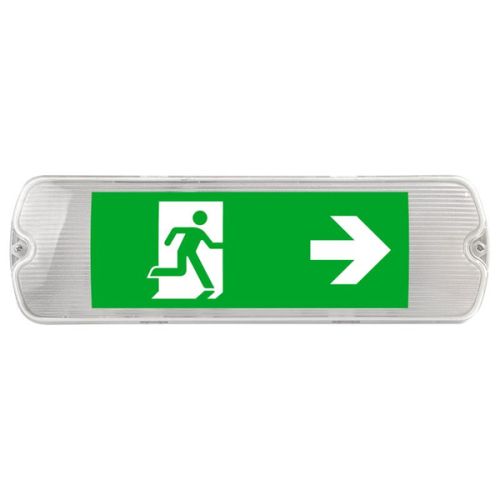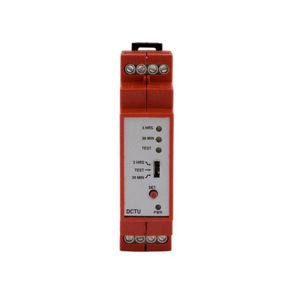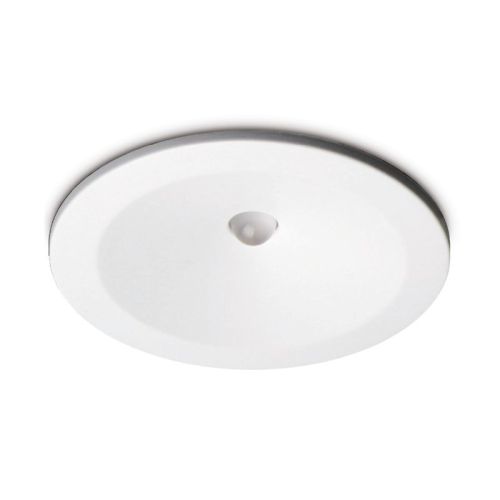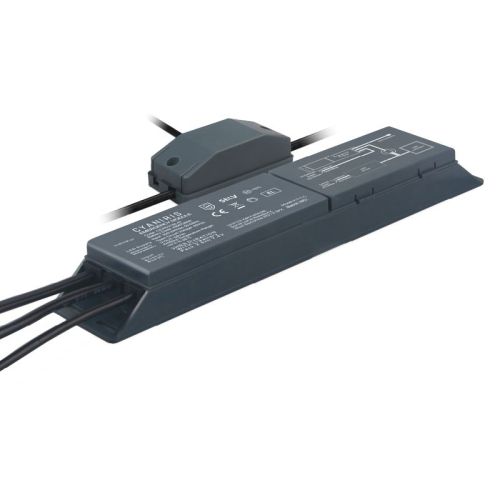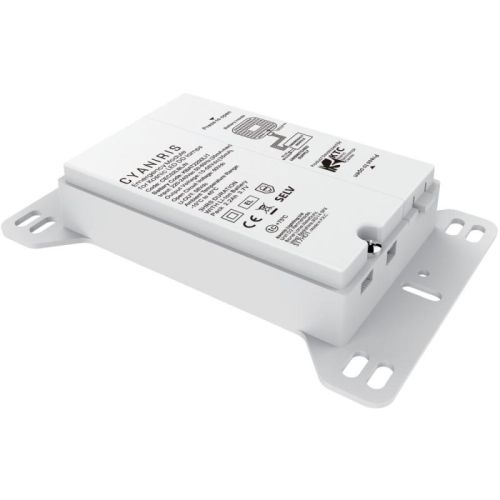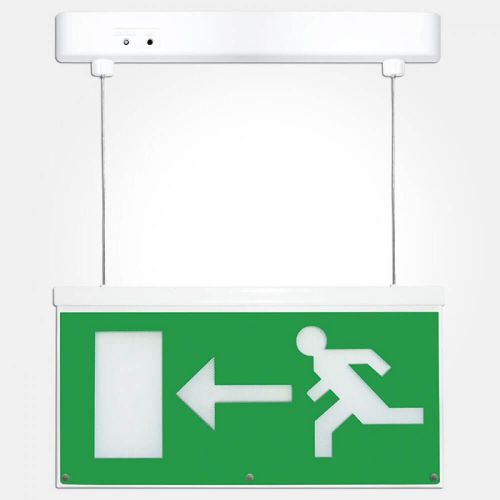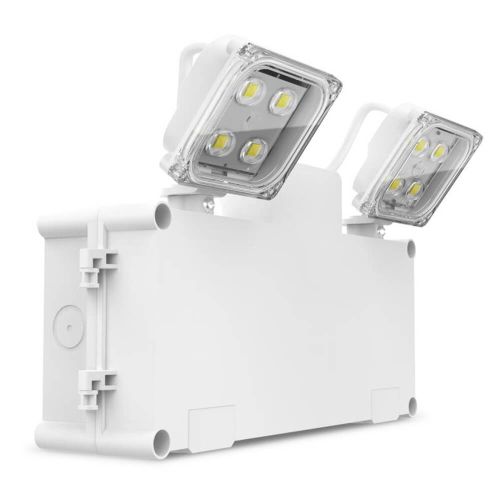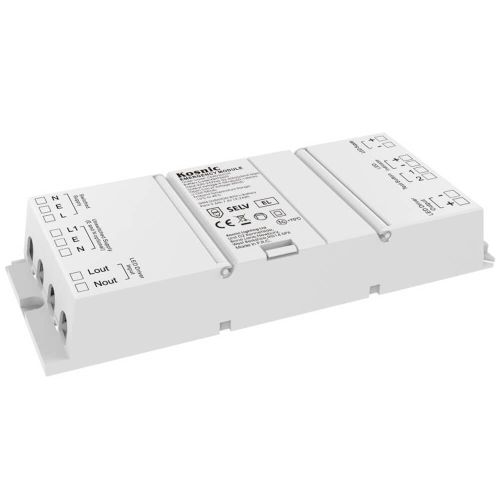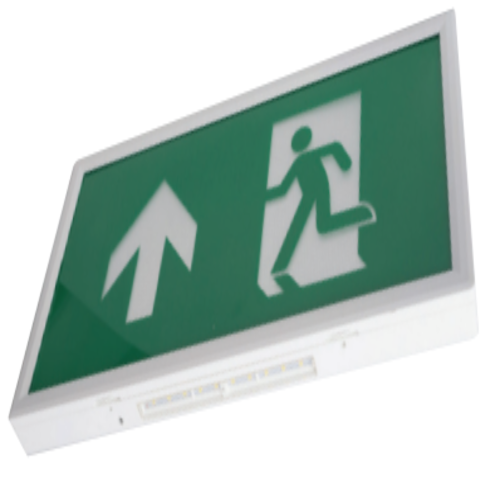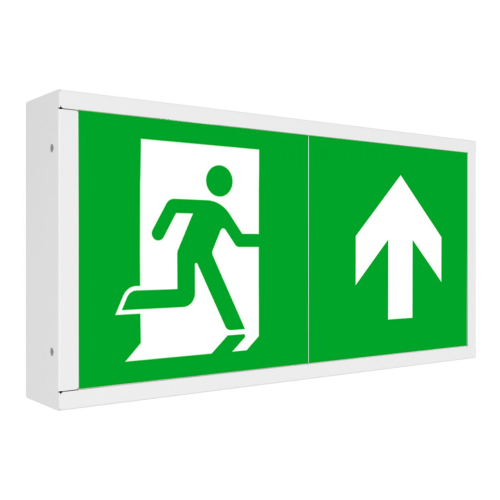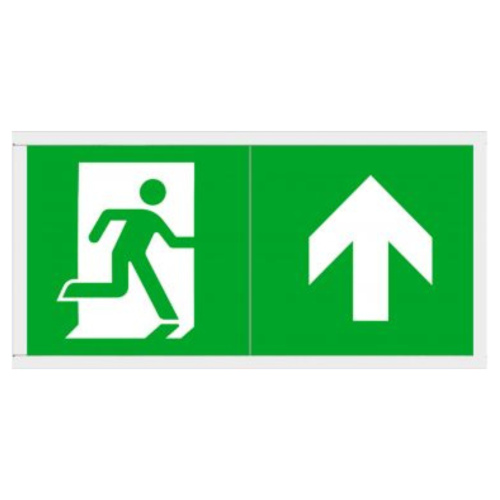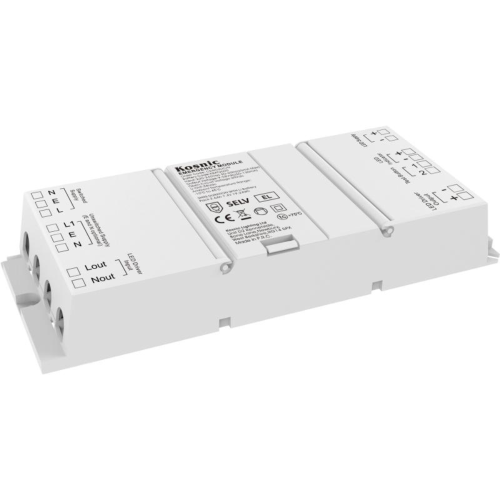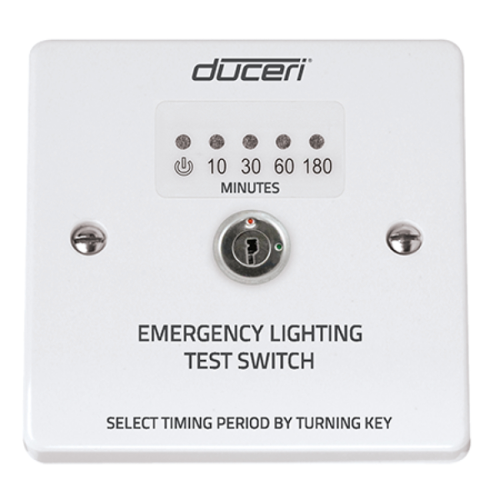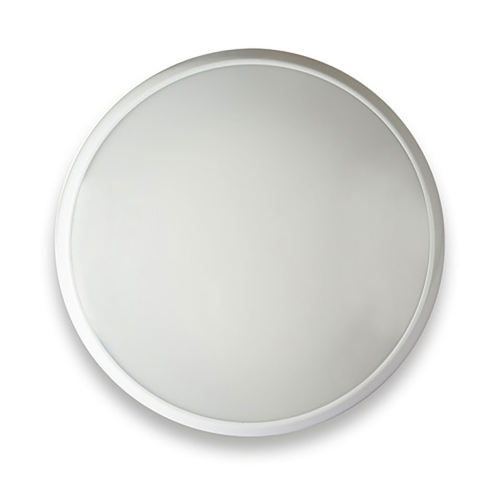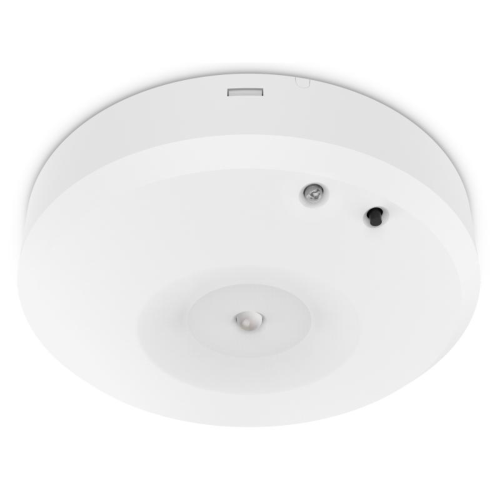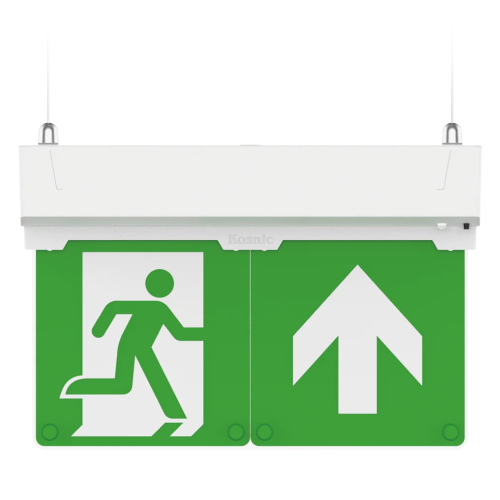Emergency Lighting
Emergency lighting provides a back-up light source in the event of a power cut, turning itself on automatically or allowing light fittings to remain on. This allows occupants to locate the exits safely and easily if they need to evacuate the building.
Emergency lighting and fire safety regulations now require nearly all buildings to have emergency lighting fitted and fully operational. Emergency lighting must be placed at or near (within 2 metres or 6 feet 7 inches) fire safety appliances such as fire alarms or fire extinguishers. Therefore, it is hugely important to select the appropriate range of emergency fittings.
There are two types of emergency lighting, maintained emergency lights and non-maintained emergency lights. So what are maintained emergency lights? Maintained emergency lights are designed so that the fittings will be lit continuously, even throughout a power shortage. This allows pathways and emergency exits to be illuminated, guiding people to a safe exit. This type of emergency lighting is popular in the likes of cinemas, shopping centres etc. In contrast, non-maintained emergency lights are designed to turn on instantly in the event of a power cut. This is a regarded as a back-up light source, again with the purpose of safely illuminating pathways for a safe exit.
Emergency exit signs can also be maintained or non-maintained. It is vital that companies have correct exit signs to comply with current regulations.
Shop our range of emergency lighting LED to ensure your home or business is efficiently lit up in the event of a power cut. The range consists of LED emergency lighting, providing a strong light output against a lower wattage, allowing you to save huge amounts on your energy costs. See our range of Emergency Lighting below:
- LED Emergency Exit Signs
- LED Emergency Recessed
- Running Man Emergency Light Legends
- LED Emergency Modules
- LED Bulkhead Emergency Lighting
- LED Emergency Twinspots
- Dinrail Test Unit
It is important to carry out an emergency lighting test once a year. The emergency lights should provide a back-up for 3 hours. We have a wide range of emergency lights for homes and businesses.
Emergency light fittings work as a backup light source during power cuts. These emergency light LED fittings turn on automatically or allow light fittings to stay on. Every building must use emergency light fittings to comply with safety codes and provide safety for every occupant.
There are several types of emergency light fittings. There are maintained emergency lights and non-maintained emergency lights. Many electricians also use LED emergency lighting. Here is all the necessary information before installing emergency light fittings.
What Are Emergency Light Fittings?
Emergency light fittings are an essential part of fire safety provision in any building, and you should not avoid the use of emergency light fittings. Emergency light fittings act as a backup light source for your building's lights.
Emergency light fittings are an essential piece of equipment during power cuts. Emergency light fittings act as a power source during power cuts or allow your light fittings to keep operating in emergencies. If there is a need for evacuation, emergency light fittings will light up a safe pathway for occupants.
Apart from buildings, you should also use emergency lights for homes. It is important to install emergency lights for home to maintain your household's safety.
Emergency lights for homes with light-up exit pathways in case of a power cut and emergency lights for homes will help you make quicker evacuations in the event of a fire. Therefore it is necessary for you to install emergency lights for homes.
Emergency light fittings are a crucial part of fire safety regulations, and almost all buildings must have emergency light fittings to be fully operational. Emergency light fittings were deemed necessary in all buildings by the Industry Committee for Emergency Lighting (ICEL).
Therefore if you own an operation building in the UK, you must use emergency light fittings. At Meteor Electrical, you can find a wide range of emergency lighting products and types of equipment. From maintained emergency lights to non maintained emergency lights. You can also find several LED emergency lights.
What Are The Different Types Of Emergency Light Fittings?
There are two common types of emergency light fittings, maintained emergency lights and non maintained emergency lights.
Maintained Emergency Lights
Maintained emergency lights are manufactured so that the light fittings remain lit continuously even in a power shortage. Maintained emergency lights allow emergency exits and pathways to stay illuminated, and these lights safely guide people to the nearest exits.
Maintained emergency lights are popularly used in shopping centres, leisure centres, cinemas, etc. Maintained emergency lights also come in the form of LED emergency luminaires. These LED emergency luminaires are great for lower energy consumption, significantly reducing operating costs.
Non Maintained Emergency Lights.
Non maintained emergency lights are designed to turn on immediately during a power cut. Non maintained emergency lights act as a backup light source and are also used for the purpose of illuminating pathways for a safe exit.
Emergency exit signs are usually non maintained emergency lights, but they can also be used used as a maintained light source. Non maintained emergency lights are typically found in offices and other workplaces. Most electricians wire the non maintained emergency light to the standard lighting circuit so that these lights respond accurately to power failures.
Apart from maintained and non maintained emergency lights, three other types of LED emergency lighting are not as commonly used.
Combined Emergency Lights
Combined emergency lights comprise two or more lights, and one of these lights is powered by the emergency lighting supply. The other light uses the normal power supply to remain operational. The combined lighting system can be both maintained or non maintained depending on your power condition and situation. Remember to ask a qualified electrician which type of combined emergency light works best for you.
Compound Self-Contained Emergency Lights
A compound self-contained emergency system is comprised of LED emergency luminaires, and these LED emergency Luminaires implement either the maintained or non maintained emergency lights. The compound system works in conjunction with the emergency power supply to provide satellite lighting.
Satellite Emergency Lights
The satellite emergency lighting system is part of the LED emergency luminaires and works as both maintained and non maintained lighting. Satellite lighting derives its power supply from a self-contained power compound.
What Are Emergency Escape Lights?
Emergency escape lights are an important aspect of the emergency lighting system. There are three important aspects of emergency escape lighting:
- Escape route lighting
- Anti-panic/open area lighting
- High-risk task area lighting
Escape Route Lighting
Escape route lighting is integral to emergency lighting because it provides illumination for evacuation. Escape route lighting allows swift and safe evacuation of people in a building. This lighting illuminates escape pathways such as corridors and stairways.
Escape route lighting also guides people to the location of fire-fighting equipment e.g., fire extinguishers and other safety equipment. Due to these qualities, escape route light is a necessary function of the emergency light system. Escape route lighting should be used in all public areas regardless of occupancy levels.
Anti-Panic/Open Area Lighting
Large public spaces and buildings such as shopping centres, museums, and exhibition halls attract a large volume of visitors who are not familiar with the layout of the building. In the event of an emergency, panic will ensure once the emergency alarm sounds.
Therefore, it is important to install anti-panic/open area lighting. This form of emergency lighting will illuminate safe pathways for visitors. Once people identify an escape route, there will be less panic.
High-Risk Task Area Lighting
High-risk task lighting is a very specific type of emergency light that provides illumination in dangerous situations. High-risk task lighting ensures the safety of people involved in a high-risk situation or process.
High-risk task lights should produce enough illumination to enable shut-down procedures. An important thing to note is that high-risk task lighting has limited use and this use is based on specific scenarios.
The above-mentioned light configurations are one application of emergency light fittings. These fixtures emphasize the role of emergency lights in safe and escape routing. It is important to assess the needs of every building and situation before installing emergency escape lighting.
What Are The Components In Emergency Light Fittings?
Emergency light fittings are built with several components that ensure your buildings stay illuminated in power cuts. These important components are:
- LED - The LED chips are an important component in LED emergency lighting. These LED chips light up when the LED emergency luminaires are powered on.
- Test Button - The test button on emergency light fittings allows electricians to simulate a power failure to test the light’s operational capabilities.
- Battery - This is the emergency light battery where power is stored for operation during power failures.
- Emergency light module - The emergency light module allows the light to supply power and charge the light fitting. The module is important for the light’s operational abilities.
- Housing - LED emergency lights to have a housing that is made from materials to suit specific environments and applications.
- Charging indicator - emergency light changing indicator has a red LED that indicates when the light fixture is actively being charged.
- Emergency light indicator symbol - this symbol indicates that the light fixture is an emergency light. The symbol is usually comprised of a code.
What Are LED Emergency Lights?
LED emergency light fittings are becoming increasingly popular. LED emergency light fittings are a popular choice for emergency lights because they provide multiple benefits.
LED emergency lights use a light-emitting diode to illuminate pathways in a power cut. LED emergency light fittings are an environmentally friendly option, and the LED emergency light fittings also help individuals save money on energy costs. Apart from these, LED emergency light fittings have several other benefits.
Higher Efficiency
LED emergency lighting uses a process called electroluminescence. In this process, electrons are combined with electron holes when LED emergency lighting is switched on. The incandescent bulbs in regular lights have a filament that burns to create light, which means energy is used up to create heat.
There is no filament in LED emergency lighting; therefore, heat is not a major issue in LED emergency lighting. LED emergency lighting is thinner and lighter, and these qualities make LED emergency lighting more economical and cost-efficient.
Apart from the filament, LED emergency lighting has a low-temperature performance, and it is digitally controlled with robust bulbs. These attributes make LED emergency lighting more efficient than other emergency light fittings. LED emergency lighting also produces 30% energy savings compared to other light bulbs.
Longer Lifespan
LED emergency lights have a 50 times longer lifespan than standard emergency lights. The burning filament inside standard lighting burns out very quickly, and this results in the bulb needing to be replaced.
LED emergency lights do not have a burning filament, and this allows LED emergency lights to operate 50,000 hours more than standard emergency light fittings.
Better Brightness
When it comes to emergency light fittings, brightness is extremely important. Emergency lights need to be bright to properly illuminate evacuation paths in dangerous situations.
LED emergency lights have some of the brightest bulbs and are much brighter than standard emergency light bulbs of the same wattage. Therefore, LED emergency lights are the best choice for brightness in emergency light fittings.
Lower Cost Maintenance
Inspection and testing are required for all emergency lights, even LED emergency lights. However, you save less on maintenance with LED emergency lights because you don’t have to replace bulbs often. The extended lifespan of LED emergency lighting means you can save money on maintenance costs.
What Are Some Important Things To Consider Before Installing Emergency Light Fittings?
Before installing emergency light fittings, you must consider some important things. It is necessary to conduct careful installation planning to get the best possible results from your emergency light fittings. Make sure to consider the following:
- The planning and design of an emergency lighting system
- The positioning of the emergency light fittings
- If the light fittings are permanent or temporary
- Routine testing and maintenance schedule for emergency lights
These parameters are crucial to getting the best use out of your emergency lighting system. Without proper planning, your emergency lighting will fail to meet safety guidelines.
What Are The Important Regulations For Emergency Light Fittings?
Emergency lightings are extremely crucial for the safety of everyone; therefore, it’s important your light follow proper guidelines. Your emergency light fixtures should meet safety regulations for them to be effective. There are multiple regulations regarding emergency light fixtures, including their testing and use.
In the UK, the standard protection code for emergency lighting is BS 5266-1. This code outlines the duties of the “responsible person,” ensuring the functionality of emergency lights and circuits. The standard also gives clear guidelines for installing emergency lights, focusing on ensuring that your power supply is not disrupted.
The regulation code includes clear working standards, and these are suitable for use by both electrical engineers and professionals. Employers and landlords should also follow these codes. The regulation code provides an understanding of emergency lighting and its importance and parameters for performance, installation, and upkeep.
According to safety regulation clauses, the emergency illumination of your lights should not be less than 10% of the normal lighting value. This evaluation should be conducted at the relevant location points.
Relevant location points include high-risk zones in emergency situations. However, depending on certain activities higher light value might be required. For example, if your building is in a darker location, you might require brighter emergency lighting. Check the BSEN1838 regulations for specific illumination requirements regarding high-risk zones.
How To Conduct Emergency Light Fittings Tests?
Routinely testing emergency light fittings is important because it ensures they work well. Emergency scenarios or loss of power supply are unexpected and sudden, so your emergency light fixtures should maintain proper functionality no matter the situation.
Some emergency lights, such as LED emergency lights, are completely self-testing. However, the majority of emergency lights require manual testing. Tests are carried out by the designated “responsible person” or a qualified electrician. You must document all maintenance checks.
One important consideration to keep in mind is that your light system will be vulnerable after a full maintenance check. The backup battery takes time to recharge after testing; therefore, always assess the risk before carrying out maintenance checks. To avoid making your battery vulnerable, conduct testing during low-risk times, such as outside working hours.
The minimum operation duration for emergency escape lighting is 1 hour and in your annual maintenance, make sure that all your light stay on for at least 1 hour. Emergency lights should stay on for a maximum of 3 hours, depending on the battery type.
How To Conduct Maintenance Check For Emergency Light Fittings?
Annual Maintenance Check
It is crucial that you conduct a regular maintenance check on your emergency light fixtures. These checks will ensure that your light system works well in emergency conditions. The best method of running tests is by doing annual reviews.
Here are some important steps you should follow to conduct an accurate maintenance check:
- Switch off the main power supply to your emergency light fixture. This will prevent electrocution and damage to the light circuit system.
- Conduct a visual inspection of your lights to ensure they are lit properly.
- Leave the power supply switched off for the full duration of the light’s rated length. This duration is usually three hours; however, the times vary in each unit. Make sure you check the emergency light’s rating before conducting the test.
- If any battery fails before the rating period, you may need to replace the backup battery.
- Record all the results after the test is completed.
Monthly Maintenance Check
Apart from an annual maintenance check, you must conduct a standard monthly assessment as well. These checks will ensure that your emergency light fittings stay in operation in case of power failures.
Here are some important steps to follow in your monthly checks:
- Switch off the main power supply to the emergency light fittings. This step ensures the safe handling of light circuits.
- Some light fixtures have a separate switch installed in the panel. This switch allows emergency lights to be tested without turning all power off.
- Make a visual inspection of your light fittings to ensure they are operating as expected.
- Document and note down any issues. Make sure to investigate the jotted-down problems further.
- Make a written recording of the full test results once you finish your maintenance check.
How To Wire Emergency Light Fittings?
To make sure your emergency lighting system functions correctly, you need to do a proper installation of your lighting equipment. Following the correct installation steps will guarantee that your emergency lighting follows safety guidelines.
Before you start installing emergency light fittings, you must make sure that the breaker in the emergency lighting is connected. This step ensures that your circuit is safe and it prevents the risk of electric shock or injury.
Additionally, you can find installation guides from manufacturers. Make sure you familiarise yourself with any guidelines or instructions before beginning the installation work.
Here are the basic steps for installing emergency light fittings:
- Make the circuit area a safe work zone to avoid accidents and injuries.
- Identify the voltage of the light connection. This voltage should reflect the emergency light fitting’s voltage capacity.
- Examine and inspect the unit connections
- Connect the common wire, and the correct voltage write to supply voltage to the electrical conduit.
- Connect the ground wire in your circuit
- Switch the light circuit on and provide the sufficient battery time to charge
- Conduct a test on the emergency lighting unit to ensure proper functionality.
Incorrect emergency light installment is hazardous, and it could lead to severe damage to the light unit, circuit board, and transformer. Due to this reason, a qualified electrician should carry out the installation task.
Another important point to consider is the mounting type of the fixture. Generally, the lighting unit is fully or partially mounted before emergency lighting wiring is connected to the main supply. However, there are various fittings available for emergency light fixtures.
Make sure to choose the most effective fixture for your emergency light model. Here are some common light fittings on the market:
- Bulkhead fittings
- Recessed fittings
- Surface mounts
- Modular fittings
- Twin-spot fittings
- Wall light fittings
FAQ's
- How long should Emergency Lighting last?
- What is a Maintained Emergency Light?
- What is a Non-Maintained Emergency light?
- What is the best Emergency lights for homes?
- What does the red light mean on an Emergency light?
- Where should Emergency lighting be installed?
- How does Emergency lighting work?
- What is the most cost-effective Emergency lighting system?
- Is it a legal requirement to install Emergency lighting?
- What is self-test Emergency lighting?
- How often do you need to test your Emergency lighting systems?
- How do you carry out a monthly Emergency lighting test?
- How do you carry out an annual Emergency lighting test?

